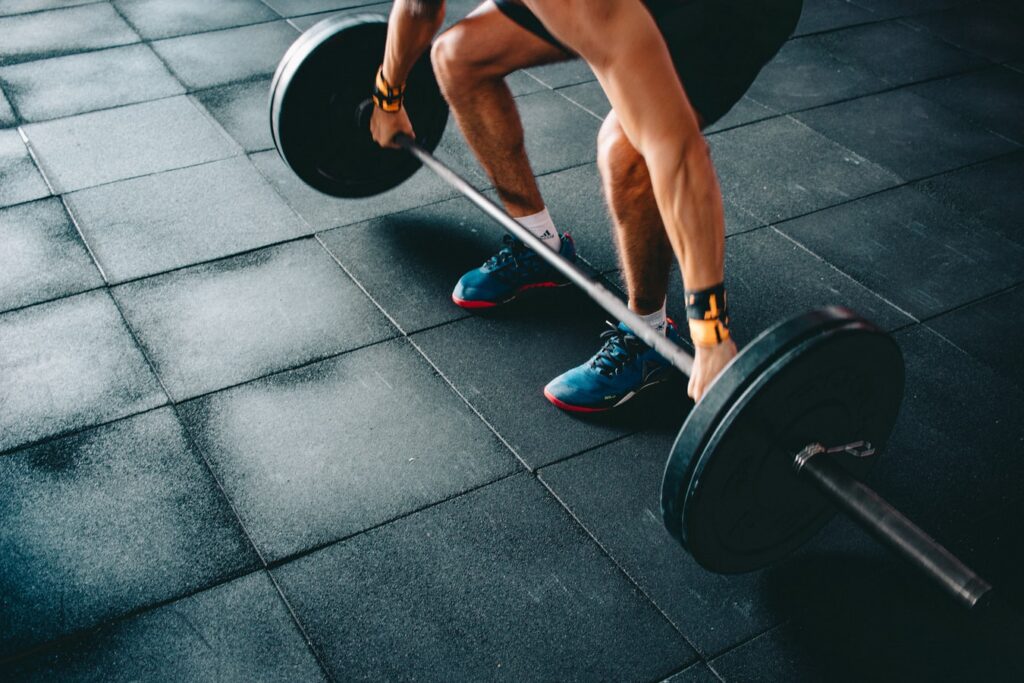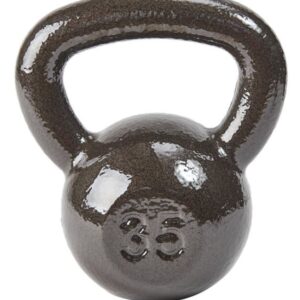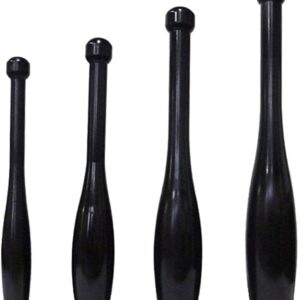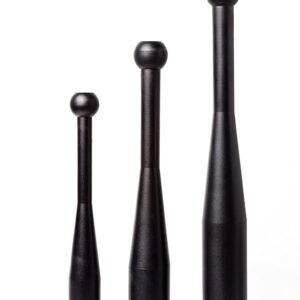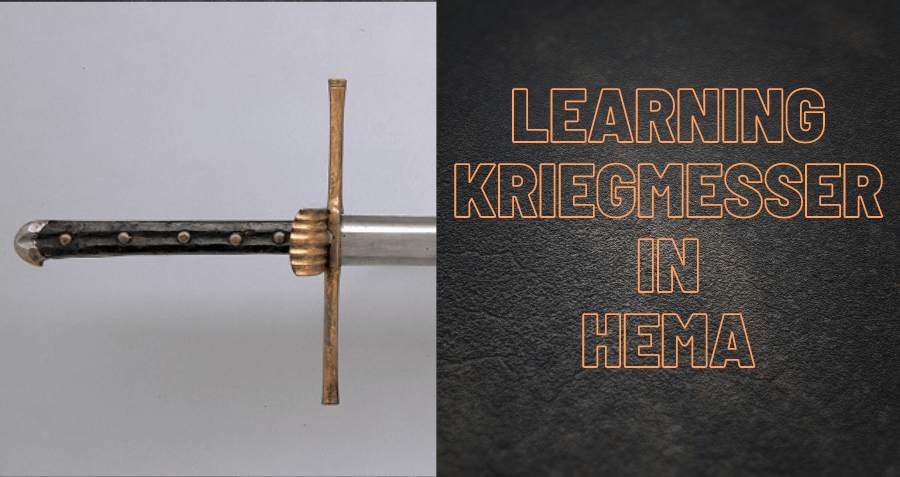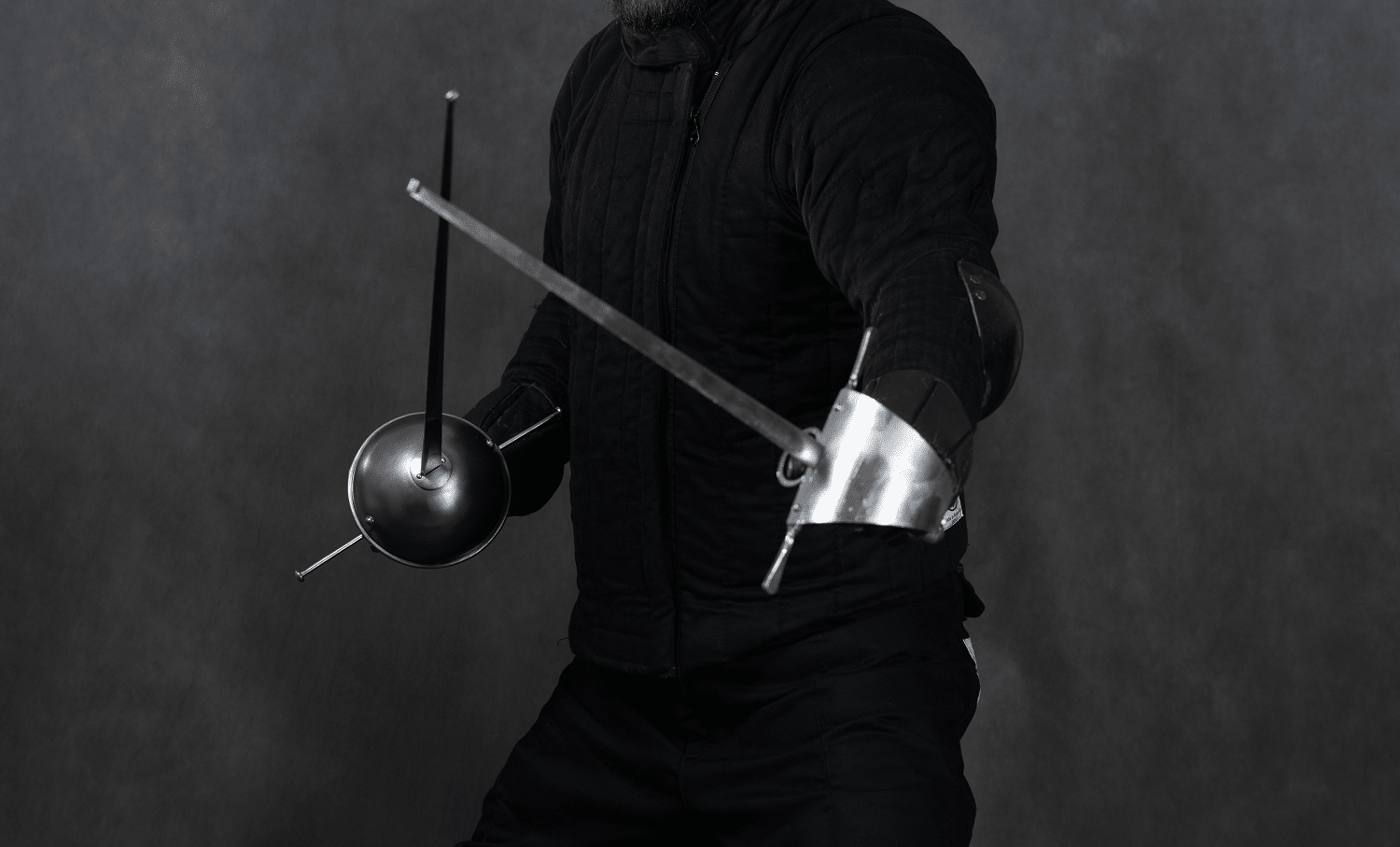In a previous article, ‘Strength Training and Body Conditioning for HEMA Sword Fighting‘ we discussed some misconceptions related to weight training and Historical European martial arts (HEMA) sword fighting, while also providing a general overview of the kinds of weight training that is most commonly done by martial artist swordsmen. In this article we will discuss more specific weight lifting exercises that are useful for developing power when real sword fighting — that is, practicing Historical European martial arts style of sword fighting. The information in this article about weight lifting exercises for developing power is also applicable to other styles of martial arts sword fighting, too, such as Kendo.
Before we go into the specific exercises we recommend for developing power in sword fighting, we need to preface this with some information about why weight lifting is useful for sword fighting training. While much of this information is common knowledge among sport athletes, many people studying HEMA have limited prior experience with sports so it is good to provide this general overview so they can understand why weight lifting will benefit them.
(It may also be helpful to read our article, ‘The Early History and Development of Modern Weight Lifting‘, to clear up any preconceived misconceptions you might possess about weight lifting before continuing to read this article. Many people are unaware that some of the beliefs they have about different types of weight lifting are incorrect. It’s useful to look at past athletes and the kinds of physiques they built with different training compared to what is often recommended today).
Why Do Athletes Lift Weights In the First Place? How Does it Help Sword Fighters?
Weight lifting is performed as an exercise with the goal to increase an athlete’s muscle size under the belief that increased size will result in an increased capacity for the athlete’s muscle fibers to increase strength.
The word Belief was emphasized in the previous paragraph, because the relationship between muscle size and strength is complex. Generally speaking, larger muscles on a human represent the potential for increased strength and endurance capacity of those muscles, although this capacity must be conditioned for the specific activities the person is doing. The human body is a very elastic machine that can optimize its operations for the type of labor the body is forced to do, which means it becomes more efficient at using resources to do work that previously was once difficult. As an example, when the average person takes up a new athletic sport as a hobby they start out struggling to do basic aspects of that sport.
- In baseball they have a hard time repeatedly swinging a baseball bat, as their muscles tire quickly.
- In basketball their legs and shoulder muscles tire quickly from sprinting while dribbling with the ball.
- In swimming their chest, shoulders and arm muscles tire quickly while freestyle stroking.
The first day of practice will leave the muscles of a beginner to these sports feeling very sore and weak the next day; however by the third day a person usually discovers their endurance level has noticeably increased when performing the basic movements of these sports. While they still lack the endurance of more seasoned athletes of these sports, the person finds they can exercise for at least double the amount of time they previously could on that first day.
While the precise physiological mechanisms by which the human body adapts to stressors is still not fully understood, it is well established that the human body’s natural response to prolonged exercise is to alter the phenotype of skeletal muscle, changing the way it stores and uses nutrients to supply energy to muscles needed for commonly encountered activities. The body can also change the number of skeletal muscle fibers that can be recruited to perform commonly encountered work, too. However, the human body is very picky about these changes — it tends to fixate on specific levels of stress placed on the muscles when performing specific movements to determine when an ‘activity’ is performed (a trait that is exploited by body builders to “shock” the muscle groups they want to grow by switching the types of exercises and precise amount of weight that is lifted to force the body to increase the size of skeletal muscle fibers after it has become accustomed to previous exercises).
For example, in body building the dumbbell bicep curl is commonly performed when seeking to increase the size of the bicep muscle but after a certain level of bicep growth the body becomes extremely accustomed to regularly performing a dumbbell bicep curl. Even when increasing the weight of the bar used to perform a bicep curl this will not result in the body increasing the size of the bicep muscles in response to the stress. Instead, a body builder must practice other kinds of exercises that still challenge the bicep muscle but utilize slightly different arm movements that cause the bicep to be challenged from different angles than the dumbell bicep curl did, such as by using cable-assisted bicep curls, or using a hammer press machine. While the bicep is still used to perform the same general movement of extending and retrieving the arm, the level of weight and angles of stress placed on the bicep slightly change, which the body does not recognize as the same ‘bicep curl’ movement the bodybuilder was using previously. This will typically stimulate the bicep to start growing again in response to the “new” stress it is experiencing.
If you are interested in learning more about the science behind how the human body can increase its capacity for exercise by exposure to prolonged exercise activity, the papers ‘Mechanisms modulating skeletal muscle phenotype‘ and ‘Adaptations to Strength and Endurance‘ will provide more information.
Think of Your Muscles as Empty Buckets
Although it is a very simplistic analogy, it is helpful to regard the size of muscles developed from weight lifting as similar to empty buckets which have the potential to store water in them. In a similar way, larger muscles represent the potential for increased strength and muscular endurance when performing specific exercises. Yet, just as how you must fill a bucket with water for it to store water, you must train your muscles to perform the movements you want those muscles to get better at.
Basically, weighting lifting will make you better at weight lifting; if you want to get better at the martial arts then you must train your body to do martial arts by practicing martial arts for prolonged periods of time. HEMA sword fighting is, ultimately, a martial art and no different.
So, being able to bench press a heavy weight doesn’t directly equate to being able to deliver a powerful boxing punch — it only means your muscles have the potential to be trained to deliver a powerful punch after prolonged exercise in practicing punches. Weight lifting must therefore be used in conjunction with the activity you want to actually get stronger at — in our case, sword fighting.
This is especially true with HEMA sword fighting, which uses many movements that are similar to but not precisely the same as movements seen in other sports. These slight differences in body position and movement are registered by the body as different exercises; for example, while lunging with a rapier is similar to performing any kind of lunge in another sport, the key difference is the way the arm holding the sword extends out while retreating with the rest of the body by shifting the shoulders forward and pulling the torso back slightly. This is a totally unique movement to the activity of performing rapier lunges, so simply doing an exercise like kettlebell assisted lunges won’t necessarily improve your rapier lunge speed and power directly; doing these weight-assisted lunges will, however, increase the size of muscles used by your legs and lower back muscles to perform a lunge-like movement, which you can then re-train by doing hundreds of rapier lunges as a floor drill.
You Must Re-Train Muscle Size Gains For Sword Fighting to See Direct Performance Benefits
It’s a common misconception that the maximum load your muscles can lift with one motion will equate to maximum force your muscles can generate with another similar but different motion. Weight lifters commonly speak about muscles in far more simplistic terms than they should, which often creates this misconception.
The way your body recruits fibers for performing work with muscles depends on what movements it has been forced to do to exhaustion. This is why doing a bench press doesn’t correlate to punching power, but repeatedly punching does improve punching power. Having larger muscles means you have more fiber recruitment capacity, since the myofibrils has increased in size. But you still have to train your muscles to be more efficient at the task you want to do more efficiently.
Bench presses will result in a faster increase in your arm and chest muscle size compared to other exercises (such as just punching), because weight lifting causes muscular exhaustion faster and more efficiently than most other sports do. When the muscles have been completely fatigued, muscular hypertrophy is the body’s reaction. As there are few other activities a human can do that will exhaust the muscles faster and more completely than weight training, most athletes practice weight training at least in some point in their sports career to quickly build up the muscle size needed for optimal play in their sports. They still have to train those muscles for those sports though.
A really excellent example of this is seen with arm wrestling. Pro arm wrestlers do bicep curls just like a body builder does, but unless the body builder also practices arm wrestling routinely they don’t get much better at arm wrestling compared to someone who does. This is because your body doesn’t register the two exercises as the same, since the resistance is different, as well as how other muscle groups work together differently when arm wrestling as compared to doing a bicep curl.
The way that I like to think about my body is that it has its own organic artificial intelligence chip — it comes with its own AI. This is your subconscious mind basically, which controls your nervous system. Your body naturally has the capacity to perform at a much higher level of athletic performance than you normally do, because your subconscious mind strives to be conservative with its resources as a survival mechanism. If you went about your daily life working at the maximum athletic you could, you’d quickly exhaust yourself just by walking around. So the subconscious instead tries to actively conserve the body’s resources. Part of conserving resources is the body stimulating growth of the muscle fibers that are commonly used so that they are stronger to perform more work, but also gradually allowing more recruitment of additional fibers, too.
Broken down simply, strength gains from weight lifting are a consequence of two things,
- The body permitting more muscle fibers to be recruited to perform the action based on how important it has deemed this activity to be. Routinely weight lifting educates the body that this activity is important.
- The muscle fibers that are used in the workout become stressed and have “micro-tears”. The body heals these tears and adds more tissue to the fibers, making the muscle fibers you are able to recruit on command larger and stronger.
So, the objective of exercise is not so much to increase your total strength, because you almost never use your total strength; only a small percentage of your available muscle fibers are used when you do things like bench press or squat. Rather, the point of exercising is to increase how well you can convince your subconscious mind to use more of your body’s resources so you can run faster, lift heavier weights, punch harder, etc. by repairing exhausted muscle fibers to be individually stronger, and expanding the amount of fibers you are allowed to recruit to perform these actions.
This means you need to establish a strong mind-body connection that allows your body to use more resources to do actions it believes are important for your life. You can’t communicate with words though — you can’t just say, “Hey body, let me use 100% of my body’s muscular strength to lift three times my body weight” even though most people have the potential to do that. The reason your body doesn’t let you do that (normally) is because it would expend so much resources to perform that work it would leave you potentially defensiveness, unable to move well and demand a long recovery period. So instead your body restricts how many of your muscle fibers you can recruit to perform an action far below the number that it actually has in each muscle group you are using.
Speaking more generally as an analogy, if the max your body could lift with no subconscious restrictions is 300 lbs but your mind restricts your body to only using 50% of your total capacity even if you are trying your best, that means you can only lift 150 lbs on command. So even if you feel totally exhausted after a big workout, your body still often has 50% of its resources in reserve. That’s why most people, even after an intense workout, do not immediately pass out from dehydration and inability to move their bodies (unless they were dehydrated before they began the workouts, anyway….). Even when you feel completely exhausted, your body is actually still keeping what is called the autonomous reserve in check, in case you need it later for survival.
Yet, many professional athletes can, with consistent training, convince their subconscious that the particular activity they are doing every day is very important and needs to be prioritized. This can allow the athlete to increase their muscle fibers recruitment limit from 50%, to 60& or even 70% recruitment for a single movement. It is said by some that rarely some athletes can even access 100% of their muscle fiber recruitment….. but the truth is, these percentages are just rough estimates — there is no hard science on precisely how much muscle fiber recruitment the average person uses or can use when at the professional athlete level. All we do know is that most people cannot use their maximum number of fibers unless the subconscious deems the person to be in a moment of crisis requiring such usage — this is called hysterical strength, the kind of thing where people are described as able to limit cars in an emergency to save someone’s life.
While this may sound the stuff of fantasy, there are documented cases of this occurring. Scientific research has also been performed into studying hysterical strength and its mechanisms, as detailed in the EPSN article, ‘Unlocking the Mystery of Superhuman Strength‘ by Scott Eden;
E. PAUL ZEHR, a neuroscientist at the University of Victoria, in British Columbia, is something of the go-to expert on the physiology of maximum human physical performance. “What we think are human limits,” he says, “are, in fact, just soft barriers.” He is familiar with the phenomenon termed hysterical strength, but, he says, “It’s not an area that gets research attention.” Why? Designing experiments to study it in human beings in the lab would be difficult to achieve, he explains, without also violating the norms of modern scientific ethics.
But those codes weren’t always in place. Consider 1961, in Chicago, where a visiting professor of physiology from the University of Tokyo named Michio Ikai teamed up with Arthur H. Steinhaus, an American physiologist and fitness expert with a Ph.D. from the University of Chicago, to run some experiments. They recruited a group of 25 people, hooked them up to a device to measure “maximal efforts to flex the forearm” by pulling on a cable, and asked their subjects to flex as hard as they could; then they walked behind their subjects and, without warning, fired a gun — a starter’s gun! — next to the subjects’ ears. Pow! They asked them to pull the device again. When scared, the subjects overall were 7.4 percent stronger.
‘Unlocking the Mystery of Superhuman Strength‘ by Scott Eden.
Now, I must say that the purpose behind pointing out this mechanism of the body is not to suggest that people should try to increase their muscle recruitment ability so they can perform a sword swing with 100% muscle fiber recruitment. Realistically, if you could do such a thing you would seriously injure yourself — perhaps irreversibly.
From the same article,
Sweat ran down from Hannah’s face and forehead. She felt lightheaded. Behind her forehead, deep in her temporal lobe, twin nut-sized neuron clusters had by this point shot an electric signal over to her hypothalamus, another neuron cluster, which in turn had activated the adjacent pituitary gland, whose function it is to broadcast a portfolio of hormonal messengers throughout the body’s various systems. Hormones triggering hormones, an endocrine cascade. The pituitary signals would almost instantly have reached two yellow blobs of tissue perched atop each of her kidneys like mushroom caps: the adrenal glands. These would then have brewed and spewed more epinephrine and norepinephrine, crucial chemicals and neurotransmitters, than almost assuredly they’d ever produced in Hannah’s young life to date.
Among other things, the epinephrine would have flooded her liver, then bound chemically with cells there to help form glucose — giving her a burst of energy, the stressor equivalent of a sugar high.
Coursing through her bloodstream, the epinephrine would have entered her heart, found the pacemaker cells there and emboldened them to make that muscle beat harder, faster, stronger — a myocardial turbocharge for the whole of her anatomy.
Hannah and Haylee lifted again … and this time the tractor moved. It moved maybe an inch in the air and an inch laterally, but it moved. Then they did it again. And again. Up and down, up and down. They were oonching the Ferguson’s front end across their father’s chest.
…
The girls bent down and hugged the tires and lifted again. It was a kind of positive feedback loop. Feelings of frustration causing energy bursts causing little lifts, which caused more frustration and more energy bursts … until finally, the tractor came off their father’s chest. The girls had moved it about 3 feet. He could finally breathe. His life was no longer in danger. When he was ultimately freed, Jeff stood up and looked at his daughters. “When your mom calls,” he said, “don’t tell her anything.”
Jeff Smith suffered only minor injuries, a broken wrist chief among them. As for Hannah, she collapsed that night in total fatigue. “I did not feel any pain until the next day.” She basically couldn’t move. She’d strained every muscle in her body from the neck down. She was bedridden for two weeks and never played competitive basketball again.
‘Unlocking the Mystery of Superhuman Strength‘ by Scott Eden.
As we do not see professional athletes collapsing on the field in total fatigue and become bedridden for two weeks after every competition, it is safe to assume that the human body cannot normally be convinced to recruit 100% of its potential strength to perform a single movement. And for good reason, as performing such an activity is life threatening to yourself.
Rather, the point of explaining this is to tell you the following,
- You are stronger than you believe you are, but the majority of that potential is ‘locked’ by your subconscious.
- With the proper training you can ‘unlock’ more of that potential to use on command whenever you want to.
The ‘proper training’ isn’t even that complicated to do; you just need to consistently exercise in the sport you want to get stronger in. Eventually, your body will decide this activity is important enough to your daily life that it needs to prioritize it, allowing you to recruit more muscle fibers to perform the movements of that sport. That will make you ‘stronger’, even if your muscles don’t necessarily ‘grow’ in size.
However, if you simultaneously grow your muscle size with weight training AND practice the sport you want to get better at, you will see significant increases in muscular endurance and power generation in that sport. Weight training is complimentary to other sports, since it is the sport that most directly will increase your muscle group sizes due to the nature of it.
So, if you want to be able to recruit more muscle fibers for swinging a sword, you just need to repeatedly swing a sword. However, if you want to see a significant increase in your endurance and power generation for swinging a sword, you should lift weights AND swing a sword.
Have Realistic Expectations for Your Strength and Muscular Size Gains When Weight Lifting
Any discussion about weight lifting that is aimed at beginners has to be prefaced with explaining that it is theorized that over half of all professional and amateur athletes abuse anabolic steroids — as do many celebrities who are notable for their muscular physiques. Because anabolic steroid usage is so common among athletes and celebrities in media today, it can lead to frustration for beginners who do not realize anabolic steroid usage is that common and compare themselves to these celebrities. The usage is so common because steroid screening tests lag behind the development of the current generation of steroid drugs and cycling that is performed by athletes. Professional athletes who use steroids can simply stop taking the drugs before entering competitions, as screening is almost never done throughout the year on these athletes. Likewise, film and television celebrities are never subjected to drug testing as most of them are not competitive athletes, so they can take whatever they want all of the time– and these celebrities can afford the most expensive designer steroids available that originally were developed for treating various kinds of illnesses (but are prescribed by unprincipled doctors for usage as performance enhancers).
Make no mistake, steroid usage significantly increases muscular strength and size gains. A study, The Effects of Supraphysiologic Doses of Testosterone on Muscle Size and Strength in Normal Men, discovered that simply giving more testosterone to men will increase their skeletal muscle strength and size, even if they do not exercise at all.
Steroid usage is so commonplace that it is no longer possible to compete in bodybuilding contests unless a person uses steroids, as the muscular group sizes of modern body builders are beyond those which can be naturally obtained.
Because anabolic steroid usage is so commonplace among professional and amateur sports athletes, much of the data that is available about sports science uses people who are on steroids or who at least benefited by steroid usage at some point in their careers. This is why ‘celebrity workout regimens’ do not produce the same results for the average person — both men and women celebrities will take steroids to bulk up for roles, as simply having more testosterone and other growth hormones in your body will significantly increase the size of muscular growth.
Having said this, there are a few phases a normal person goes through in weight lifting — what is often called the “beginner” phase where “great gains are made”, as is said by many weight lifters. These gains are made regardless if the person is engaging in powerlifter or body building weight lifting, or even with kettlebell training. This “beginner gains phase” is actually the natural phase of muscle growth a person will experience, which will continue until a person reaches their genetic limit of muscular hypertrophy. The average person not using anabolic steroids reaches this limit within 3 years of consistent weight lifting training. To surpass this limit requires doping with anabolic steroid usage, mostly synthetic testosterone, but even with these limits surpassed a person will experience diminishing returns, and at some point the muscles hypertrophy to where a lot of wasted energy is spent by the muscles to perform work — making the muscles inefficient for labor, over taxing the cardiovascular system. The above-average muscle size also cannot be maintained without continual abuse of the drugs, which inevitably leads to other health problems for the body builder. This is especially true for men because using anabolic steroids causes the male body to stop producing its own natural testosterone, which causes infertility issues as the presence of synthetic testosterone in the blood stream negatively affects the hypothalamic-pituitary gonadal axis, inhibiting the production of follicle stimulating hormone and luteinizing hormones. This has been confirmed in the study titled, ‘Testosterone Is a Contraceptive and Should Not Be Used in Men Who Desire Fertility‘. Anabolic steroid usage also negatively impacts women, too.
It’s not a coincidence that the most common cause of death among body builders competing at the professional level is a heart attack (or other organ failure), often while under the age of 40. For this reason body builders have an above average fatality rate compared to other men of their same age group.
The purpose of pointing this out is to tell you two things,
- Don’t use steroids.
- Don’t expect to gain the same muscular size gains and physique appearance as people who do use steroids.
As a beginning weight lifter seeking to find reliable information about weight lifting, you have to be careful when comparing your own training results from weight lifting to those gains made by prominent figures in the media. There are many fitness programs advertised as used by celebrities and professional athletes that market themselves to average, normal people yet withhold the fact these people were using steroids the entire time. For most of these training routines you will not get the same results in the same time period.
It’s not natural for a person to pack on 25 lbs of muscle in a year while having an extremely low amount of body fat, as many celebrities routinely do. Even when looking at the photos and advice provided by Instagram fitness models you must consider this, because these drugs are very easy to obtain and many people use them even at the amateur level (it is pretty much impossible to become a professional body builder unless you have been using steroids for several years, so obviously many amateur body builders must take them).
So, when you see advice in magazines or blogs about how you have to “work all your muscles to complete exhaustion to gain any muscle size” and perform complicated, multi-hour training programs all day long…. you must understand this data is tainted because it’s using people that have abused anabolic steroids, who are trying to get their body to grow muscle groups to sizes beyond the normal genetic limits they were born with. This advice is simply not applicable to beginners to weight lifting. Such high intensity workouts are not necessary for beginners and without steroids to help with recovery time, many people won’t be able to do them, either.
Firstly, as mentioned previously, “complete muscle exhaustion” isn’t actually possible outside of a life threatening crisis. After exercising your body will always have many muscle fibers in reserve that it simply refuses to use in case you need them.
Secondly, the body can indeed grow its muscle fiber sizes through prolonged exercise and weight lifting is not the only way– weight lifting is just the best way. This is because weight lifting will exhaust muscle fibers faster than any other sport exercise will, but any exercise done for a sufficiently long enough time period will eventually exhaust muscle fibers and stimulate growth. As mentioned in our previous article, strong men from the 19th century primarily built their physiques using gymnastics, not weight lifting. This is still seen today by gymnasts (and other similar sports, such as wrestling), who tend to develop very muscular physiques without doing weight lifting at all.
Historically, very heavy workout loads like modern weight lifting didn’t really exist until the past century, and people gained muscle size by doing regular physical labor activities throughout the day — the same way that people who still do a lot of manual labor as a career naturally gain muscle size.
Simply knowing this information will help you manage expectations for what you will get out of weight lifting, and also help you realize that you do not have to hit the gym weights as hard as professional body builders do in order to see size gains. Until you have been regularly lifting for a few years you will not reach your maximum genetic limits and now start needing to “shock” your muscle groups into growing further. And without steroids most people will never gain the kind of muscular group sizes that professional celebrities and athletes obtain.
The following photos are the physiques of strong men taken before synthetic testosterone were developed and represent what the average man or woman can realistically develop.
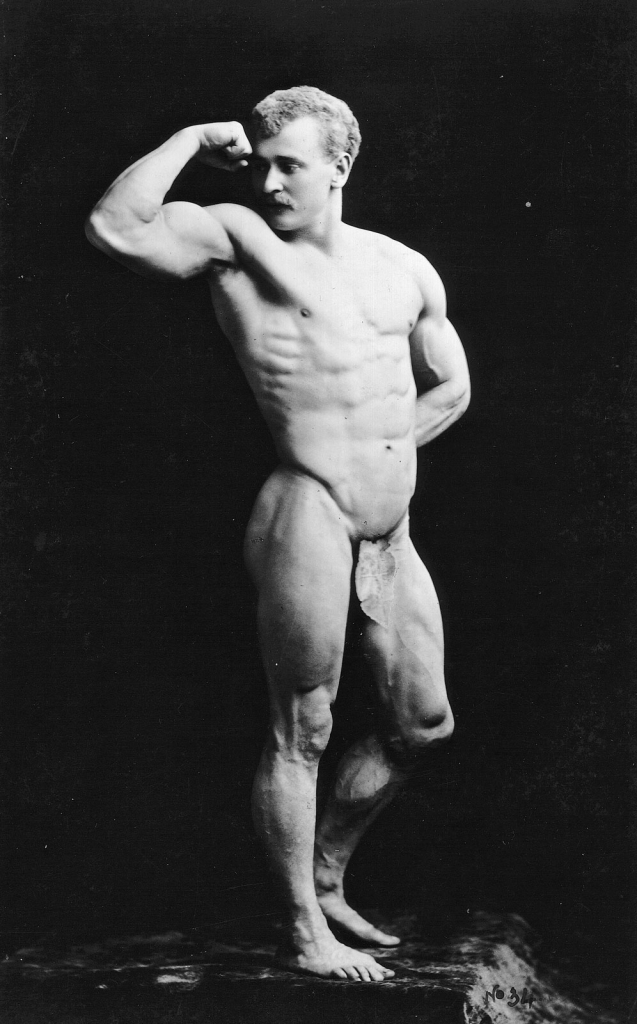
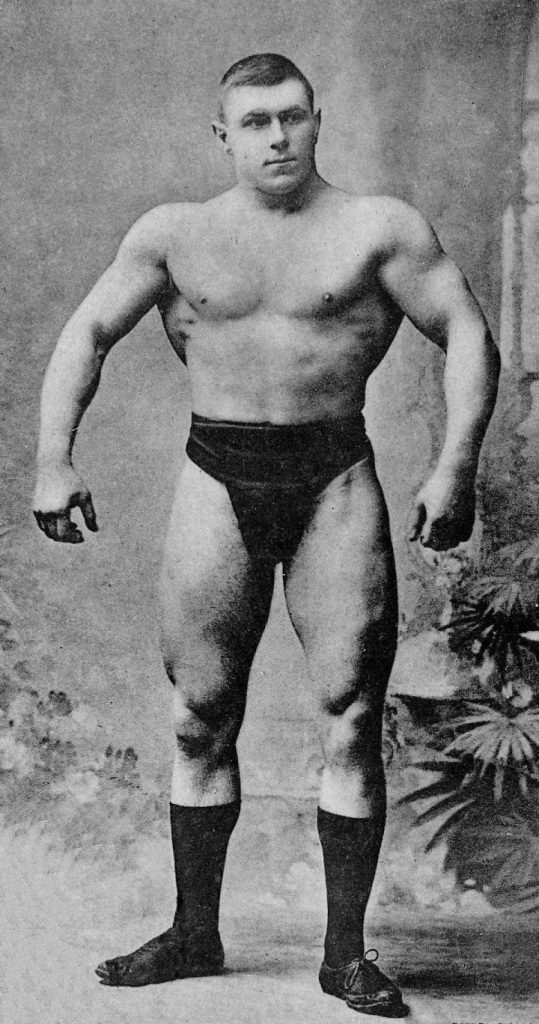

These are realistically obtainable physiques without steroid usage and the standard by which people should actually measure their results from. Don’t measure yourself based on photos you see of people on Instagram or from celebrities in magazines, as they are likely enhanced.
Having realistic goals and expectations will keep you motivated. Many people give up weight lifting because they don’t use steroids and become disappointed when they don’t get the same results as those who use them but do not realize these people were using steroids.
Developing Rotational Strength for Real Sword Fighting
Now having covered preparatory information about how weight training works, why you should do it and what kind of results you should expect we can get into the meat of this article, which is the recommended exercises for HEMA sword fighting.
While any weight lifting exercises will trigger growth if they exhaust muscles, the most efficient weight lifting exercises for time and energy spent to reaching muscle size gains will be power lifting exercises such as the bench press, squats and dead lifts. For each exercise do three sets of 12 reps, using weight that is heavy enough that by rep 12 you need to rest for a minute before doing another set. Do this at least three times a week.
You can also do more Olympic style weight lifting exercises such as the snatch and the clean and jerk, or even the clean and press. It doesn’t really matter which of these exercises you do, so long as you exhaust the muscles by challenging them with weight for three sets of 12 reps with each exercise that works the major muscle groups of the body. Avoid doing ‘ego lifts’ or trying to max your rep with the most weight you can lift — this is not necessary for building muscle. The objective is to work the most muscle groups you can in a single motion, which reduces the time you spend at the gym.
You do not need a complex weight lifting routine to develop your muscles as a beginner, and regularly performing these basic, staple weight lifting exercises will trigger muscular size growth. It is only seasoned weight lifters who need to “shock” their muscles with a wide range of different exercises to trigger muscle size growth after they have plateaued from their “newbie gains” phase ending. So, you do not need to do fad workout programs like the 5×5 weight lifting regimen as a beginner to see muscle size gains — as a beginner, you’ll probably waste more time at a gym than you need to if you do these type of programs. This is referred to as ‘junk volume’ within the weight lifting community — volume that will not contribute to your strength and muscle gains. Beginning weight lifters have a lower threshold for junk volume than more seasoned weight lifters do, which means more conditioned weight lifters require more volume to continue making gains whereas beginning weight lifters can make gains with less volume.
For those who doubt that significant muscle size gain is possible with such a simple weight training routine, it is worth mentioning that before Arnold Schwarzenegger became a body builder he was an Olympic weight lifter and also a power lifter. This is what Arnold looked like in those days, before he started doing the body building style of weight lifting he became better known for.
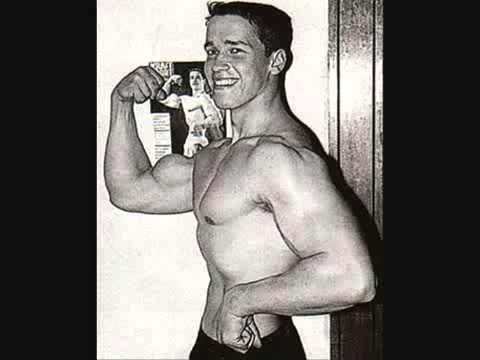
What I would suggest supplementing your weight training with is an emphasis on developing the muscles used for rotational power generation; that is, the ability for your body to deliver fast and powerful sword swings. To do this requires developing the size of your rotational muscles, primarily those of the lower back, torso and shoulders that are used when swinging a sword. You want to grow these along with the muscles of the obliques and abdominal muscle wall, as well as the muscles of your legs and hips, too.
An excellent video that covers ways of developing rotational power has been produced by the YouTube channel The Bioneer.
Kettlebell swings for rotational power in sword fighting
Kettlebell swings are excellent at working the muscles used for rotational power generation. Exhausting muscles using kettlebells will definitely increase the sizes of these muscle, and increase their capacity for power generation.
If you are seeking to purchase some kettlebells I recommend these models which are available for purchase.
Weighted Club Exercises for Rotational Power Generation
Weighted clubs are a modern version of Indian clubs. These look something like a small baseball bat but come in a variety of different weights. Indian clubs were developed by martial artists in India and are still used today among Indian wrestlers. Their movements lend themselves well to developing rotational power, too. One advantage they have over kettlebells is they better develop the muscles in the forearms and wrist, which is useful for sword fighting.
Atlas Swings with Dumbbells Or Kettlebells
Atlas Swings can be done with a dumbbell or even a kettlebell. It is an excellent exercise for core development.
For more ideas on exercises you can do that will be beneficial for HEMA, check out this video,
Strengthen Your Neck to Protect Against Concussions
It is important for athletes in any type of contact sport to strengthen the muscles of their neck. It has long been known among boxers and other martial arts athletes that strengthening the neck greatly reduces the risk of getting a concussion, as the neck muscles better stabilize the head and absorb some of the shock the skull receives. A recent study has also provided some evidence for what has long been observed among contact athletes. Some studies have found that every one pound increase in neck strength leads to a decrease in five percent chance of sustaining a concussion.
Weighted neck raises are some of the best exercises for strengthening the neck. Some weight lifting gyms may also have specialty weighted neck training machines that allow training the neck in multiple directions.
Dietary Advice for Weight Lifting
Your body needs proper nutrients to recover from the damage to the muscles when you stress it with weight lifting. Please read our article, ‘Nutritional Advice for Martial Artists‘ for more detailed information on this topic, especially in regards to protein needs for muscle growth and recovery.
****
Responding to some criticism this article has received
There has been some criticism by some on social media toward this article because the advice encourages a workout that is at odds with popular training methods of weight lifting. The main criticisms are due to confusions about what hypertrophy is (versus how the term ‘hypertrophy’ is commonly used in a non-scientific way by many weight lifters) and that Olympic style weight lifting is ‘dangerous’, and programs like 5×5 would be better for new weight lifters..
To respond to the criticism:
First of all, Hypertrophy IS the way your fibers get stronger, period. Your fibers cannot get stronger if they do not grow in size, this is how your body works. Your fibers are physical, organic things. They get stronger by having more material added to them during the healing process. The idea you can get your muscles to be stronger without them growing in size is mistaken, the only way that would happen is if the type of material your muscles are made from changed. Since the type of material is the same, it requires more of that material to be stronger.
If you disagree with this definition of hypertrophy, it is suggested you watch this video produced by James Linker.
The confusion stems from people also not understanding they can see strength gains in their lifts without necessarily seeing a large size increase in their muscle group, because they are less aware that with more consistent training your body also allows you to recruit more fibers to do more work. While you cannot physically see this happen because it happens beneath your skin, all muscles fibers do not get equal workouts, because all fibers are not all used at the same time. When muscles fibers are exhausted, they must heal. Your ability to keep lifting after a short rest isn’t because those spent fibers “recover” in seconds, it’s because your body is allowing you to recruit different fibers, up until the max amount it will allow you to recruit. Because this biological fact about how your body works isn’t considered by many weight lifters, they don’t fully understand how weight training works at a biological, mechanical level and how their bodies as a machine is operating. Which leads to this confusion stemming from inaccurate training beliefs like “hypertrophy training”.
Another mistaken belief is that simply by lifting heavy weights your strength for other unrelated motions will increase, which is not necessarily true. While your body does make it easier for you to recruit more fibers when performing totally different movements when you do weight lifting regularly, this is not a linear line of strength progression for totally different moves, even if they use the same muscle groups. This is the same reason why doing a lot of smaller weight many times won’t give you as much strength gain for the lift in question as just lifting heavy all the time.
In a specific example, doing a bench press 100 times per set with just the barbell won’t allow you to gain more strength in your bench press as using progressively heavier weights and smaller reps will, because your muscles are not being challenged to lift heavier weights. So your body does not realize it needs to recruit more fibers simultaneously to perform the action, since it can perform the action using a smaller number of fibers. Likewise, if you don’t need to recruit as many muscle fibers to do a totally different action, it won’t recruit that number, either. So the only strength gains you see from lifting heavy with a bench press in other motions that use the arms and chest is from having strengthened (hypertrophy) the fibers that will be used for those other motions that do not have the resistance of your bench press. Because the level of resistance is different, your body refuses to recruit the same number of fibers to perform those actions. It will only recruit the fibers it needs. So making those fibers it does recruit stronger = more power for those actions.
This is how cross training with weights actually works, which is again why saying you want hypertrophy as a goal in weight lifting for martial arts is correct. Lifting heavy on barbells will still create the same amount of hypertrophy as lifting a lower weight to exhaustion, but lifting very heavy increases the risk of injury by placing more stress on joints. This means lower reps has less chance of injury but provides the same benefit to the martial artist (muscle fiber size increasing) so it is more optimal to do this. Which is why this article encourages power lifting and Olympic lifts.
The article does not, as some have assumed, encourage to lift very heavy weights when doing these lifts. It is implied by the number of reps (12) that a person should lift a decent manageable weight that offers challenge and will exhaust muscle fibers, but only by the last few reps.
Lifting specific amounts of weight with the goal of lifting heavier and heavier weights, shouldn’t necessarily be the weight training goal of martial artists. You’ll never do a bench press in a fight of any kind, so how much you can bench press (through recruitment of muscle fibers) is irrelevant. But, if you build up the muscle fibers used to weight lift as large as you can, the movements you actually do in the martial arts will be stronger, since the muscles that get the biggest are the ones your body will recruit to do all those actions. This is because it’s primarily fast twitch fibers which are used for martial arts, which are exhausted the easiest when you do your first few sets of reps when weight lifting.
To help illustrate this in your mind, using a random made up number, let’s say you only use 15% of your muscle fibers in the muscle groups used to throw a boxing punch to do each punch. You want those 15% of fibers recruited to be stronger, and to be stronger they must grow larger. While doing a bench press to lift double your body weight might require as much as say 40% of the fibers in your arms and chest, just because that action requires that many fibers doesn’t mean your body will recruit 40% when you throw a punch. It doesn’t need 40% to throw a punch, the level of resistance is far less so it can instead just use 15% of the fibers. Your body has no reason to recruit more to throw a punch, so it still only limits you to use 15%. So make that 15% the best they can be, which requires an increase of their size. And because you can get that hypertrophy of the 15% from higher reps, lower weights without the same level of risk of joint injury as heavier weights, it makes more sense to do lower reps when your weight training goal is to cross train for martial arts — which is what we are talking about here.
If you want to increase the number of fibers your body can use when you throw a punch, you have to throw more punches. But throwing these punches takes a lot longer to grow the size of the muscles, since your body will never use as many fibers to throw a punch as it will when doing something like bench pressing. So weight training used in conjunction with martial arts training will result in the best and fastest increases in strength for martial arts usage, since weight training causes the most amount of hypertrophy but you still need to do the movements of your martial art to convince your body to let you recruit more of these fibers to use them for martial arts fighting.
Lastly, doing something such as the 5×5 weight training program as a brand new lifter will produce identical muscle size growth results to simply doing power lifting or Olympic lifts for 12 reps, 3 sets with manageable weight. This is because it’s not until you are a more experienced lifter that your body will need more intense, muscle isolating focused workouts to be convinced to recruit more fibers, and to grow those fibers larger. Fibers cannot grow in size infinitely; there is a limit to how much each can grow. The body naturally doesn’t want you to be a mass monster, because the larger your fibers are, the more resources are spent to maintain that size and perform work with them. So as a body builder trying to become a mass monster you have to keep increasing the size of other fibers you may not normally use in everyday life, which requires more intense workouts to force your body to allow you to use them, exhaust them and then heal them. But when you are in first years of lifting, you’ll never be able to recruit those ‘held in reserve’ muscle fibers because no matter how hard you lift, your body won’t let you. You have to develop your other fibers first, the ones you mostly use in daily life, and then steadily over time, with consistent workouts, your body will allow you to gain access to those reserve fibers and develop them, after you have constantly kept exhausting the ones you have been developing for years.
Programs like 5×5 were developed for the needs of seasoned body builders, not for beginners. So 5×5 and other body building programs produces the same hypertrophy results for beginners as just doing power lifting or even Olympic lifts will, and since these latter lifts are more complex using more muscle groups (they work more groups at the same time) this will result in less time spent in the gym for beginners while giving identical gains as 5×5, for beginners.
It should be noted that while strengthening muscles requires increasing their size, their comes a point where that growth produces diminishing returns on strength. While mass monster body builders can grow a large percentage of their muscle fibers to be very big by using steroids and intense muscle isolation weight lifting exercises, the reason they don’t then see a strength increase in proportion to this abnormal size is because the amount of resources the body spends to maintain the size restricts how much power the fibers can perform; they are still restricted by resources the body can supply the muscles when performing work. People unfamiliar with this might mistakenly think that being that “big” like a body builder doesn’t give them functional strength. In fact, real muscle always has functional strength, but being strong isn’t just about size but also on your body’s ability to fuel those muscles. Many pro body builders have grown to a size the body cannot fuel the muscles properly to take full advantage of the size the muscles have grown to. The other lesser known issue is that many professional body builders inject synthol in small amounts into their body to make muscles look larger than they are. This is done sometimes by people who are not body builders and gives them a comical appearance, but when done by actual body builders who have reached the limits of hypertrophy through steroids, the use of synthol can be unnoticeable at first glance, unless you touch their muscles.
Hopefully this clarifies some of the confusion people have.
*****
We hope this guide helps you start your journey into learning historical sword fighting.
If you’d like to learn more information about historical fencing practices please check out our Learn HEMA page for a guide to learning about the historical weapon that interests you. You can also find more guides we’ve written about other topics at our Helpful Guides page. You can also join the conversation at our forums or our Facebook Group community.
